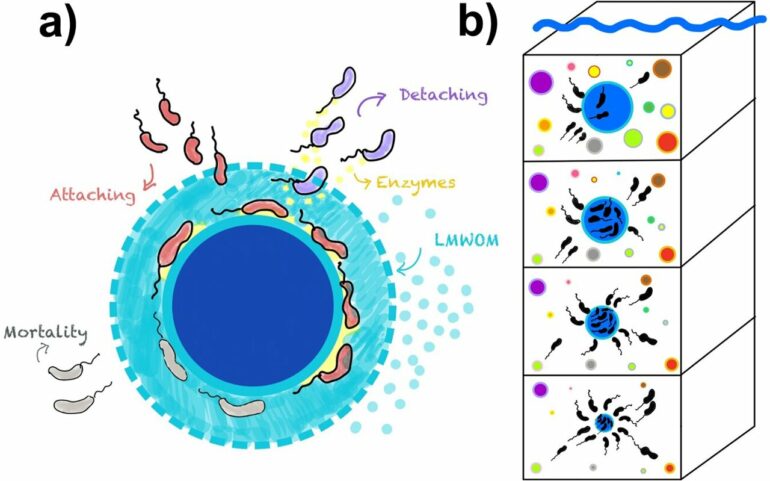Call them hitchhikers; the microbes that latch onto particles at the ocean’s surface have a big job. They ride along until they reach the bottom, transferring carbon to the deepest waters of the ocean. The journey can take weeks to months, though estimating the rate has been a challenge—until now.
A USC-led team of international scientists has found that the speed of this carbon transfer is influenced by the size and type of bacteria that latch onto the particles. The discovery has enabled researchers to develop a computer model for estimating carbon transfer, a part of the Earth’s natural carbon cycle to stabilize its climate, in oceans across the globe.
That discovery, published Monday in the journal Nature Communications, sheds greater light on how carbon—including pollution from cars—moves from the atmosphere into the ocean, and ultimately makes its way into the deep ocean, said Naomi Levine, an assistant professor of biological sciences, quantitative and computational biology and Earth sciences at USC Dornsife College of Letters, Arts and Sciences.
Knowing the carbon transfer rate could help scientists better understand just how well the Earth is retaining carbon in the deepest parts of its oceans—or whether much of the carbon that normally would sink is returning to the atmosphere, Levine said.
“This is the first time that we’ve been able to build a model to predict ocean-scale carbon-cycle dynamics that accounts for these micro-scale processes that have been observed in the lab,” Levine said. “We show that the processes matter a lot.”
Because of microbes’ outsized role in transferring carbon, scientists are interested in also understanding their colonies and survivability. Without them, “carbon falls deeper into the ocean. This impacts how much CO2 stays in the atmosphere,” Levine said.
Some like it hot
By some estimates, the ocean stores 38,000 gigatons of carbon—up to 16 times as much as is found in the Earth’s biosphere. Carbon dioxide is among the carbon that ends up in the oceans. While it drives up ocean surface temperatures, it is essential for some life, such as phytoplankton—the plants of the ocean. However, increasing CO2 makes the water more acidic, which can threaten the survival of some oceanic organisms—including corals and kelps that are the main dish for marine life.
The research team found that the rate of carbon sinking in the ocean—and the depth at which the transfer occurs—also depends on how far down the bacteria travel on the ride of their lives. For some bacteria, it’s a relatively short trip, and unlike those half-eaten particles, they never make it to the deep ocean, which is more than 1,000 meters from the surface. Healthy colonies of bacteria, on the other hand, raise the potential that the carbon—released as the hungry hitchhikers munch on particles—stays in the surface ocean and returns to the atmosphere.
“There is a lot of mortality or death with these bacteria. That impacts the rate at which they can break these particles down,” said Trang Nguyen, a study co-author who is a USC Dornsife post-doctoral research associate. “By breaking down the particles, they also release nitrogen and phosphorus back into the ecosystem, which is a critical part of the cycling of these elements.”
And knowing which bacteria live in which locations of the oceans could also help scientists adjust the model to better predict a local rate of carbon transfer—or release, depending on whether the bacteria are thriving or not.
Levine collaborated with researchers at the Massachusetts Institute of Technology, UC San Diego and ETH Zurich in Switzerland.
More information:
Trang T. H. Nguyen et al, Microbes contribute to setting the ocean carbon flux by altering the fate of sinking particulates, Nature Communications (2022). DOI: 10.1038/s41467-022-29297-2
Provided by
University of Southern California
Citation:
Scientists can predict carbon transfer in the ocean based on deep-diving tiny organisms (2022, March 31)



